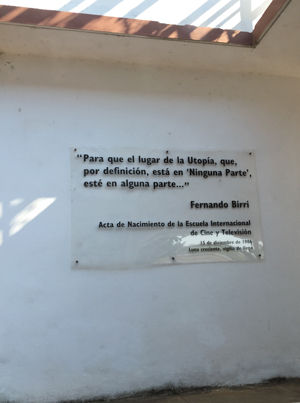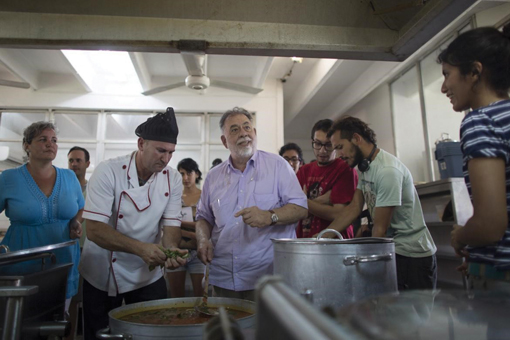Cinematic Exchanges
José Arroyo, Principal Teaching Fellow In Film and Television Studies at the University of Warwick, underlines his experiences teaching at Cuba’s world-renowned Escuela Internacional de Cine y Televisión.
 About the Author: José Arroyo studied Economics at McGill University, Film Studies at the University of East Anglia and Communications at Simon Fraser University. He is co-founder of The Montreal Mirror and was awarded the AQEC-Oliveri Prize for Best Text Written on Film in 1989 for ‘John Grierson and the War for Men’s Minds’. He has been a columnist on gay culture for Angles in Vancouver and ‘The Wide Lens’ column for The Conversation. He has contributed film criticism to a range of media outlets including Sight and Sound magazine, Front Row on Radio 4, The Cinema Show/ The DVD Collection for BBC TV and many others. José has taught Film Studies at Concordia University in Montreal, Simon Fraser University in Vancouver, Ramon Llull University in Barcelona and EICTV in Cuba.
About the Author: José Arroyo studied Economics at McGill University, Film Studies at the University of East Anglia and Communications at Simon Fraser University. He is co-founder of The Montreal Mirror and was awarded the AQEC-Oliveri Prize for Best Text Written on Film in 1989 for ‘John Grierson and the War for Men’s Minds’. He has been a columnist on gay culture for Angles in Vancouver and ‘The Wide Lens’ column for The Conversation. He has contributed film criticism to a range of media outlets including Sight and Sound magazine, Front Row on Radio 4, The Cinema Show/ The DVD Collection for BBC TV and many others. José has taught Film Studies at Concordia University in Montreal, Simon Fraser University in Vancouver, Ramon Llull University in Barcelona and EICTV in Cuba.
Escuela Internacional de Cine y Televisión (EICTV) in San Antonio de los Baños, Cuba, was recently voted in the top five filmmaking schools to watch by The Hollywood Reporter. It was founded in 1986 by Colombian novelist and Nobel Laureate Gabriel García Márquez, Argentine filmmaker Fernando Birri and the Cuban producer Julio García Espinosa with the support of then-President Fidel Castro in order to provide as close to an ideal context for students from the ‘Three Worlds’ of Africa, Asia and Latin America to study film – already considered the greatest of arts – but also television and video. At the time these media were considered particularly crucial to documenting, representing and shaping reality. In its founding statement was written the phrase that is framed over the school’s entrance and shapes its ethos: so that utopia as a place, which by definition is nowhere, may exist somewhere.
The Cuban state provided the land and oversaw the design and construction of the various edifices that make up the school: residences for staff and students, auditoria, sound and editing studios, offices, football fields, track areas and an Olympic pool. The school was designed to be close enough to Havana to allow staff and students contact to theatre, book fairs, music and art. Aside from sport and exercise, there’s not much to do except talk, think and dream the audiovisual.

The program is extraordinary: aside from classes, which take place during the day, every evening there are talks, often from distinguished foreign visitors, and a whole spate of cinematic and televisual options on view in the schools three projection rooms. Along with the classics (of which the school can be proud of a more international scope and broader definition than is usual) its where I first saw Eastern block westerns, mid-century Soviet classics and Argentine musicals. In this little oasis on a small Caribbean island which is enduring a long-term and punishing embargo and might seem closed off, students constantly surprise by seeming to have seen so much and by being so eager to see and discuss more. Dancing can interrupt the reverie at any time, usually at El Encuentro, the school’s coffee shop bar that’s open 24 hours. It’s a productive scheme.
The school is in the middle of agricultural land and there’s a bit of a home farm feel to it, with the surrounding farmland providing fresh food for the school’s kitchens. There are, of course, permanent staff, each distinguished in their field, who lead and run the departments of production, direction, screenwriting, camera, sound, editing and digital media. The initial founders dreamed up an ingenious system of workshop-based teaching where directors, sound men, cinematographers, critics, academics and just about anyone involved with any aspect of film culture, arrive for a two week period, teach what they know, and then the same mini-bus that returns them to the airport brings in a new set of skilled people to share their knowledge. Artists of all kinds, from all over the world, have been eager to go to EICTV to share and learn from what the school has to offer. I’ve been privileged to be a passenger in that van once a year for the best part of the last decade.
For myself as an academic, part of the pleasure has been being around practicing filmmakers, committed to their work, who want to teach what they know. In the last year alone Francis Ford Coppola, who first visited in 1987 and warned students that ‘art never sleeps’, returned to give a workshop, brought his wine, took over the cafe where everyone from the lowest to the highest eats the same food, and made pasta for the whole school. And, Abbas Kiorastami ran a workshop from 25 January to 5 February where 35 filmmakers got to develop a short under his guidance and supervision. Of EICTV, he said: ‘there is no doubt in my mind that this is the best school in the world.’ It was the last occasion the great Iranian artist was able to pass on his knowledge to a younger generation before his untimely death on 4 July 2016.
Other filmmakers who’ve lectured at the school over the years include Steve Soderbergh, Agne Varda, Robert Redford, Costa-Gavras, Emir Kusturica and an endless list of luminaries from Spain and Latin America. The last time I was there I had the opportunity to get to know Juan Madrid, Laura Rascaroli, Andrés di Tella and many others, and this is without even mentioning the brilliant students who have already begun making their mark, screening their work at Cannes and other festivals: Hector Silva Nuñez, Marco Olmos, Andres Farías Cintrón and Miguel Angel Moulet, all of whom it has been a privilege to teach and befriend.
Over the course of their degree, the workshop/guest lecturer system means that the approximately 80 students spread over the three years of the program who arrive from all over the world will have thus benefitted from the knowledge of around 300 professionals distinguished in their field, who also arrive from all over the world. It’s an international school with a strong Latin American base.
The challenges in teaching there have been considerable. The first time I was asked to give a series of lectures on genre to scriptwriting students. What use could the basis of the Warwick teaching system – close reading, detailed textual analysis – be to scriptwriters? Well, it turns out, quite a lot. They were used to discussing structures, arcs, beats and characterisation, but colour, music, composition, movement and rhythm were still not quite part of their vocabulary. Eventually, we broke through such barriers. It’s one of the great things about the school: it’s designed to do so, and to get the most out of you.
One initial panic was the teaching hours: Monday-Friday, 09.00-14.00. If you are teaching film practice this time can be easily filled with passing a camera around and asking students to do exercises. But I was used to the lecture/seminar format, and it takes a lot of material to cover those hours, every day for two weeks. At the end of each module there’s a kind of remnant of the old Communist system where everyone gets together with a mediator and does an autocritique, a kind of collective evaluation. It’s terrifying but also constructive, polite and useful. It seemed to have gone ok and I was asked back.

The other form of teaching I did there was open lectures that everyone can attend. I hosted a different one each day for two weeks, and the challenge was to keep them returning after the first day. I ended up doing a series on the films of Ernst Lubitsch, which began with Lady Windermere’s Fan (1925). I’d been warned against using a silent, black and white film with no Spanish subtitles, however, the students ended up adoring Lubitsch. Yet, these things are never a given, and one is always surprised by what they take to, what they resist, what they need a little nudge in order to appreciate. Students in Cuba loved the elegance, the simplicity, the geometry and the melodrama of Lady Windermere’s Fan. (In England, students preferred The Shop Around The Corner (1940) and found Lady Windermere’s Fan dull.) It was silent and black and white, and perhaps I spent too much time trying to convey to them theories of aesthetics and not enough time pointing out why it is such a great work of art. What I found is that there’s a difference in reception from students wanting to learn how to make and aiming to please, and students wanting to be pleased in order to learn.
Cuba is poor and so is the school. Over the years I learned to bring everything I might possibly need, from films to electronics to basic plugs. However, what is lacking materially is more than compensated by a can-do collective ethos of mutuality and exchange. It might take time but every problem can and will be solved. Dialogue is the key. The experience underlined to me is that learning is an exchange; that when one expects to simply receive without taking part in the conversation, what one receives isn’t worth taking; that there’s nothing more conducive and more productive to learning than a process of exchange and mutuality channelled into a collective goal. That’s what EICTV is about, and it’s also a kind of metaphor for cinema at its best.
 Learning on Screen
Learning on Screen